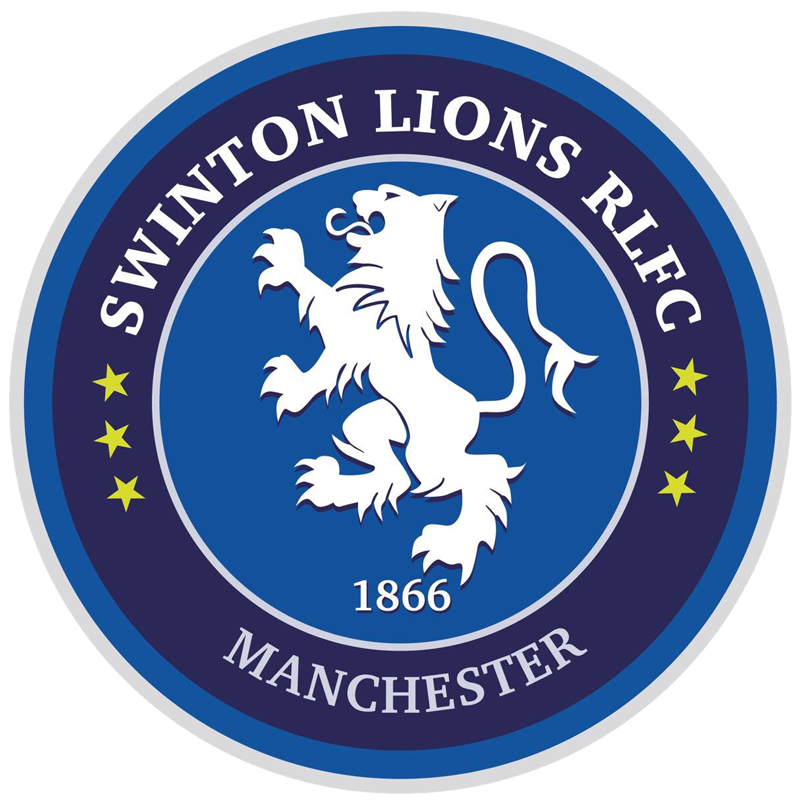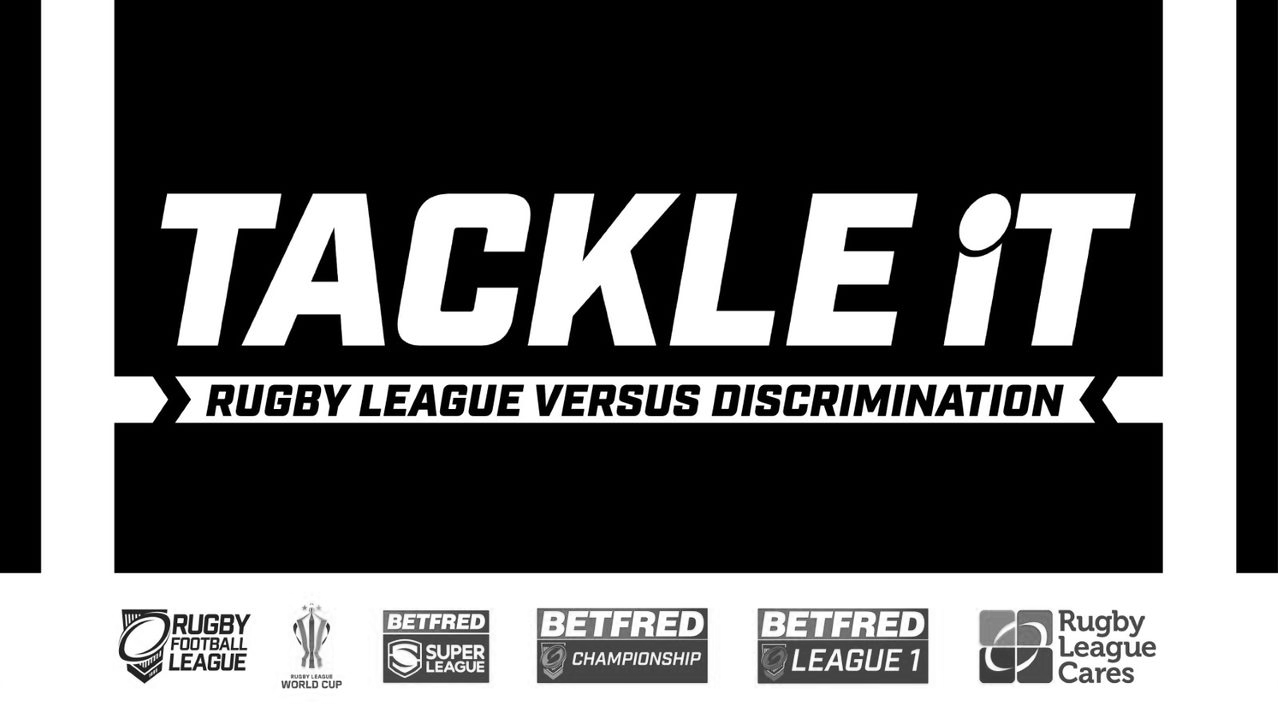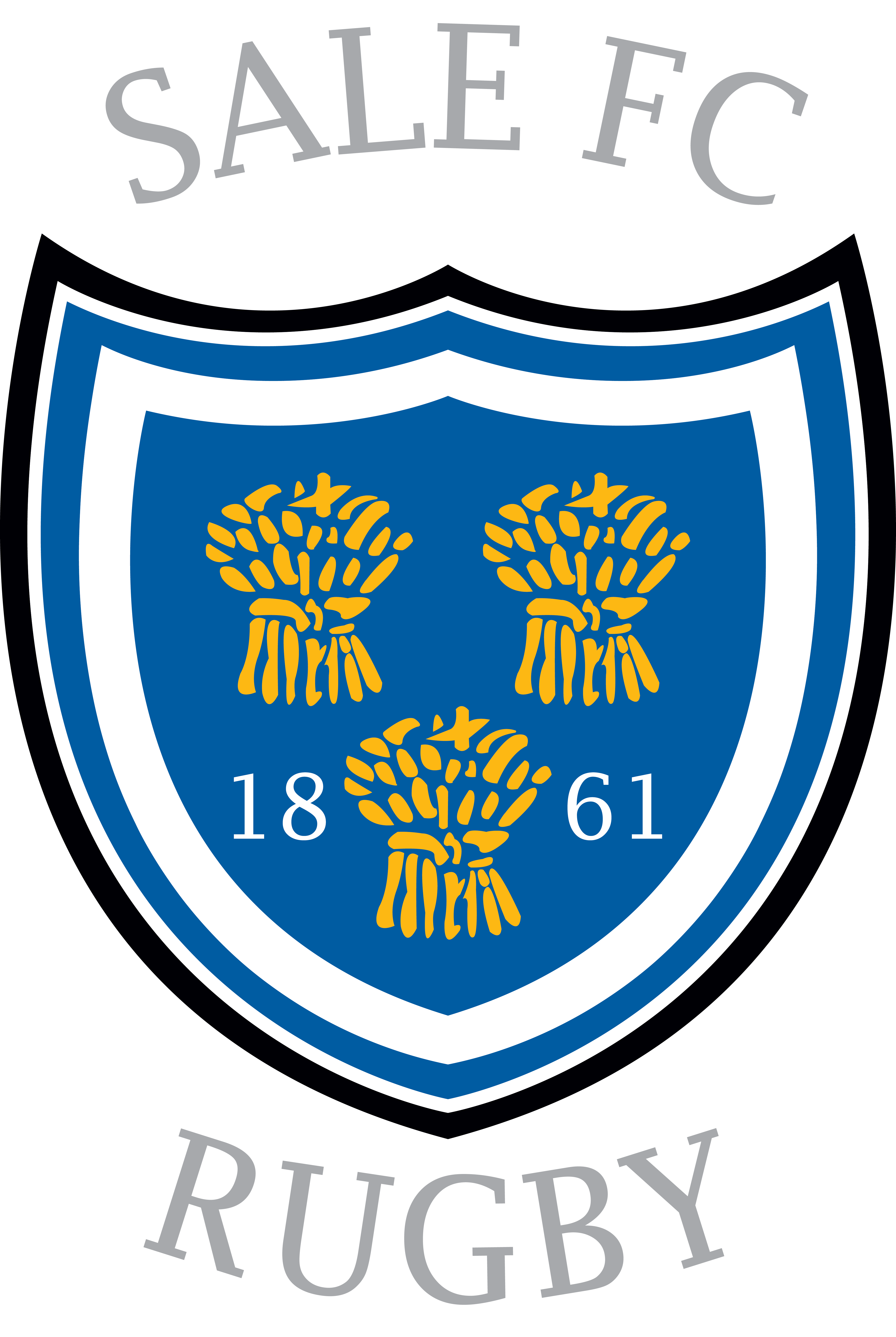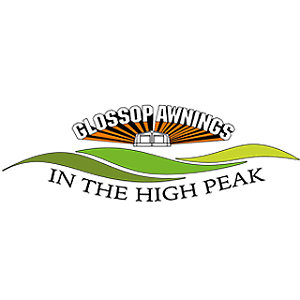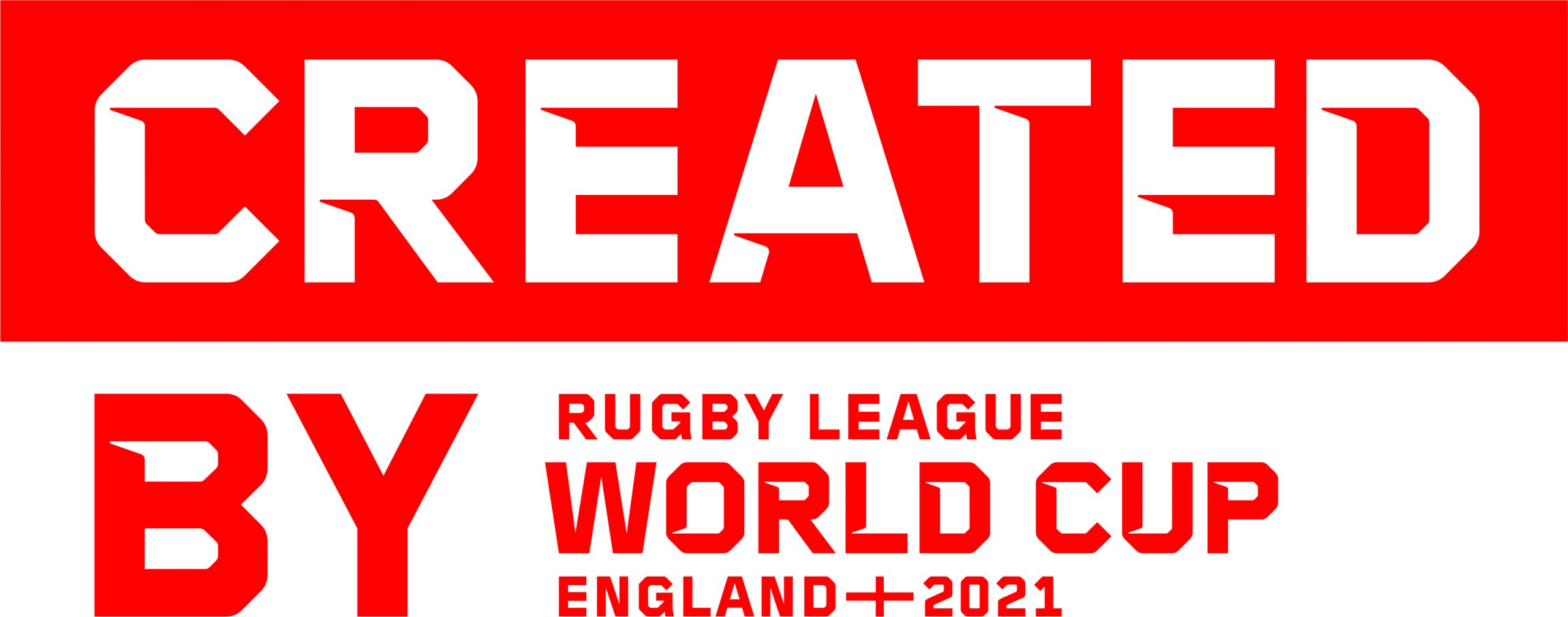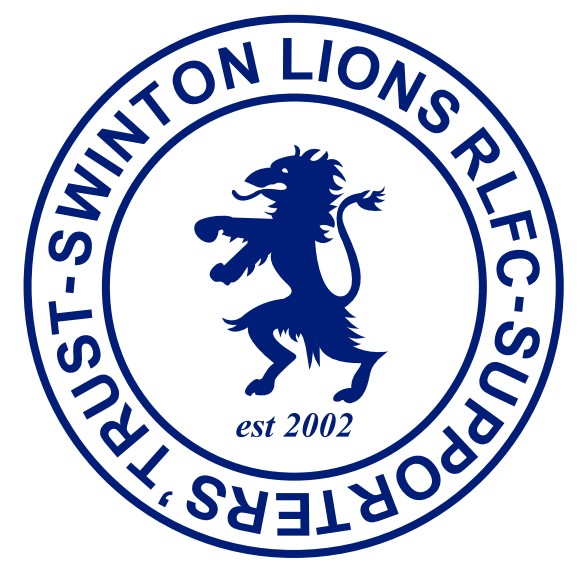ANNIVERSARY SPECIAL – 2nd JANUARY 1869 – THE STORY BEHIND THE FIRST EVER MATCH.
02 January 2021
The date of 2nd January marks an important anniversary in the history of Swinton Lions Rugby League Club. On this date, way back in 1869, Swinton played its first-ever “competitive” game.
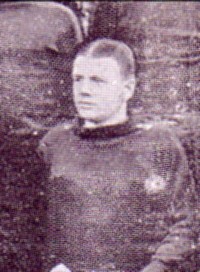
Pictured Above – John Dorning
Their opponents on that historic day were the Number One Company of the 46th Lancashire Rifle Volunteers, an organisation which itself was central to the lives of many townspeople, and who would themselves contribute a good number of players to the fledgling Swinton club.
This is the story behind that historic occasion. However, for completeness, let us place the game in the wider context of the history of the sport as a whole, and indeed in the history of the town.
The village of Swinton in 1869
Back in 1869 local traditions of pig farming and domestic hand-loom weaving had made way for the industrial revolution. Cotton spinning mills had arrived in Swinton over the previous twenty-odd years, and down in the Irwell Valley coal mining was increasingly gathering significant pace. The 1869 population of Swinton (which was less than 8,000) was set to double over the next decade, but even so, by the late 1860s Swinton was still essentially a remote rural village.
Since 1842 the landscape at the centre of the village had been dominated by the imposing structure of the vast Swinton Industrial Schools, which was a residential establishment for poor or orphaned children. Here they would receive an education and basic training in a trade, although the conditions were undoubtedly harsh. Charles Dickens had been a notable visitor in 1850, prompting him to write a short story, “A Day in a Pauper’s Palace”. He wrote, “At an easy distance of five miles, on the road from the great cotton capital to the great cotton port, through shady lanes and verdant meadows, lies the village of Swinton.”
Swinton had only become an ecclesiastical parish in its own right in 1865 (separating from Eccles), but from a local government perspective it remained part of the Township of Worsley until 1894. The Swinton District Board of Health was set up in 1867, and with it came the village’s first extensive piped water supply. A railway station was still 18 years away (1887), and transport into Pendleton, Salford and Manchester was by horse-drawn omnibus along secluded country lanes.
Across Pratty Brow (the top bit of Partington Lane) from the Industrial Schools stood St Peter’s Chapel-of-Ease, a basic place of worship that had stood there since 1791. However, on 18th April 1868 the corner stone of the new St Peter’s Church had been laid, funded by public subscription to the tune of £17,000 (£2 million in today’s money). The new church was eventually consecrated on 2nd October 1869 – albeit with a still incomplete tower.
Swinton Football Club – The Beginning
On the local sporting front, Swinton Cricket Club had been founded in July 1866. Its organisers, and a good percentage of its early playing members, were very much associated with both the church and Swinton’s middle-classes. The cricketers obtained land from John White, and established a playing field to the south of Jane Lane (now Swinton Hall Road) on a site now occupied by Lilac Drive and Cherry Drive. The first President of the Cricket Club was the Vicar of Swinton, the Reverend Henry Heywood Robinson.
Robinson was in the “Chair” when a meeting of the cricketers took place at St Peter’s Schoolrooms on Saturday 20 October 1866. Not to be confused with the current school, these buildings were on the site of the present day Swinton precinct, in a school that itself was just three years old at the time. The primary reason for the meeting was fund-raising for the Cricket Club, but an historic decision was also taken, since it was decided to play “Football” on Saturday afternoons thereafter. Hence the origins of Swinton Rugby Football Club were sown.
For the next couple of years club members would engage in cricket during the months of April to September, and then play “Football” between October and March. “Football” matches were played amongst the members and were known as “Sides games”. Teams would be chosen on varying themes, such as married men versus single men, Pendlebury men versus Swinton men, or based on age groups etc.
In those early days the concept of playing another club from elsewhere was alien. For a start not many other clubs existed on formal lines, and those that did, such as Manchester, Liverpool and Sale were either of a status outside of Swinton’s reach, or transport to and from Swinton was too problematic. The most likely reason, however, is that there was simply no inclination to play games outside the enjoyment of the club’s own membership.
How did rugby football come to Swinton?
But what about the actual game that the men of Swinton were playing? For starters it’s important to understand the terminology in its historic context. The use of the word “Football” should not be confused with what we now recognise as Association Football or Soccer. “Football”, both of the “Rugby” variety and the “Soccer” variety, have complicated origins and have gone through extensive evolvement before arriving at the sports that we are familiar with today.
Rough and ready games of multiple varying descriptions – with the use of a ball or pig’s bladder being the only unifying feature – had been played in England for centuries, but organised games as we now know them owe their origins to the public schools of southern England. From the early 1800s each school would adopt its own rules, usually conforming to their surroundings.
At Rugby School in Warwickshire for example, the extensive grass fields gave rise to a running and handling game where impact collisions would not tend to cause serious injury, whereas other schools with a hard-court playing surface might preference a kicking and dribbling game. Hence gradually two contrasting styles of “Football” began to emerge.
In 1863 the newly founded Football Association proposed that all organisations should adopt the “Cambridge Rules”. This was the first serious attempt to unify the rules of “Football”, and whilst many organisations adopted these rules others were not so sure. Indeed many schools and some early private football clubs rejected the rules of the FA – most prominently Blackheath – principally because Blackheath favoured handling and hacking which had been banned under the FA’s new set of laws. However, it wasn’t until January 1871 that sympathisers of the “Rugby School” type game had their own governing body to turn to – which came to pass with the formation of the Rugby Football Union in London.
The start of “Football” in Swinton falls midway within the eight-year gap between the formation of the two respective governing bodies. However, because early match reports from 1869 describe the handling of the ball, it’s clear that the Swinton members preferred the “Rugby-type” game from the outset. Indeed, as early as October 1871, the Swinton club had formally joined the Rugby Football Union under the name “Swinton & Pendlebury Football Club”.
In Swinton it was the middle classes that were involved in the cricket and “Football” activities of the late 1860s. Aside from class differences alone, the main reason as to why early members tended to be the middle and upper classes was the fact that at this time Saturday was a working day, and the working classes would not have had the opportunity for such frivolous past-times even if they had wanted to join in. It wouldn’t be until an Act of Parliament in 1874, which made leisure time on a Saturday afternoon a legal right to all workers, that “Football” clubs with a true working-class background began to emerge.
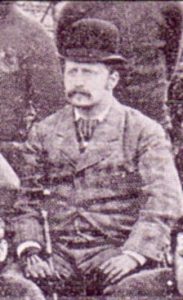
Pictured above- Harry Longshaw
The Opponents – The 46th Lancashire Rifle Volunteers
Referring back to Swinton’s first-ever opponents on that historic day back on 2nd January 1869 – i.e. the Number One Company of the 46th Lancashire Rifle Volunteers. But just who were these men, and what was the organisation they belonged to?
Volunteers (1794 to 1813)
The English “Volunteer” movement owes its origins to the European political situation of the late 1700s and early 1800s, when there was a genuine fear of a French invasion. This threat initially arose following the French revolution of 1789, and was exacerbated again with the ascendency of Napoleon Bonaparte in the decade from 1804 onwards. Hence Volunteer companies were formed across the land with the intention of providing local defence forces, roughly along the principle of the Home Guard during World War Two.
First raised in parts of England in 1794, these Volunteer groups were usually put together by either private or municipal enterprise. Enlistment and membership was entirely voluntary and the men were not required for military service abroad. These units were not subject to standard military regulations and could therefore reform and disband at will. Members could sign up and leave at their pleasure with no minimum length of service. Command was vested in the Lord Lieutenants of counties who, in turn, were responsible to the Home Office.
Although at the start of the 1800s Swinton was a tiny rural village of not more than a few hundred inhabitants, the local population was not slow to respond to the national emergency, and under the command of a Stanley Bullock Esq, a Swinton Volunteer unit was raised as early as 1804. However, by 1816 the unit had been disbanded following Wellington’s victory at Waterloo a year earlier which, at least temporarily, had eliminated the French threat. The people of Swinton celebrated that victory by roasting an ox over an open fire on land diagonally opposite the Bull’s Head.
The Volunteer Force (1859 to 1908)
Again set against the threat of a French invasion, the concept of a Volunteer Force was resurrected from 1859. These groups comprised mostly of rifle units, although there were also artillery, engineering, and cavalry formations. Members of the Volunteer Forces were exempt from service in both the regular army and militia. The basic organisational unit was a Company, for which the minimum and maximum strengths were set at 60 and 100 men respectively.
The Volunteers were initially independent from each other and lacked co-ordination. But in 1860 the War Office authorised a system of consolidating battalions whereby several companies from a town or city became part of a larger units known as Administrative Battalions. Incidentally these Volunteers Forces ceased to exist in 1908, and were replaced by the Territorial Army.
In the 1860s, and under the terms of their engagement, the “Volunteers” were obliged to attend eight days of drill and exercise within each four month period, or alternatively commit to 24 days over the course of a year. They had to pay for their own equipment, uniform and arms, and only received expenses if on official “drill”.
However, in Swinton, and no doubt elsewhere, the Volunteers also enjoyed the opportunity to stage social occasions. Sports Days and Rifle shooting events were commonplace, and for example on 14th August 1869 an “Athletic Festival” took place on the Swinton Cricket Ground. Participation was open to the Volunteers themselves, but also to any resident of Swinton, Pendlebury or Clifton. This event also marked the opening of the original Cricket pavilion, and amongst the sports were a 100 yards flat race, a 100 yards heavy marching order race, a running long jump, a running high jump, a quarter mile flat race, a 100 yards sack race, and the putting of a shot.
46th Lancashire Rifle Volunteers
The 46th Lancashire Rifle Volunteers were raised at Swinton on 24 February 1860, and that October became attached to the Fourth Administrative Battalion. As the term indicates, for administrative purposes this brought together the 46th (Swinton and Eccles), 55th Leigh, 60th Atherton, 67th Worsley, and the 76th Farnworth companies into a larger battalion.
The 46th Lancashire Rifle Volunteers were themselves split into two companies. Number One Company was comprised solely of Swinton men, whilst Number Two Company was based in Eccles. By the time of the historic “Football” game against Swinton FC in January 1869, the Number One company comprised of 97 active men.
The First Match
Hence it can be clearly seen that Swinton’s first-ever “competitive” match was very much a local affair, and a good crowd was attracted to the playing field alongside Burying Lane (now Station Road). The exact location of this field is difficult to ascertain, but old maps indicate a likely site in the rough location of the present day Buchanan Street, or possibly another field which subsequently succumbed to the coming of the railway. The goalposts were described as the “upper goal” and the “lower goal” so this suggests a playing alignment with the rise of what is now Station Road. (Incidentally Burying Lane was so named because that was the route taken by funeral corteges from Clifton and Pendlebury on their way to Eccles, back in the days when Swinton did not possess burial grounds. It was renamed Station Road after the opening of the railway in 1887).
On the morning of Saturday 2nd January 1869, the men of Swinton Football Club and the 46th Lancashire Rifle Volunteers are likely to have emerged from the Bull’s Head public house in their rudimentary football gear – Swinton clad in all navy blue woollen outfits – on their way to play the historic encounter. Note that the Bull’s Head had been established as the club’s inaugural headquarters, and would remain so until around 1873 when they removed to the White Lion.
First the footballers would have witnessed the half-built tower of the new St Peter’s Church, standing alongside the old Chapel-of-Ease that had yet to be demolished. Then turning up the semi-rural Burying Lane, off they went to play a game of seven-a-side, of a sport roughly resembling rugby football. Perhaps they took their personal effects with them, as it’s reported that in these early days clothes and belongings would often be stored under a canvass sheet, pegged out in a corner of the field, and watched over by a non-playing club member.
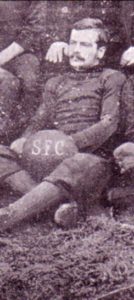
Pictured above- Walter Longshaw
The following is an extract taken from the St Peter’s Parish Magazine, dated February 1869:-
SWINTON FOOTBALL CLUB v No.1 COMPANY 46th LANCASHIRE RIFLE VOLUNTEERS
This match was played on the ground of the former, on Saturday the 2nd of January, and, after a pleasantly contested game, terminated in a victory for the 46th, by five goals to one. The weather in the early part of the morning was very unfavourable, though it fortunately came out fine just as play commenced. The ground too was so slippery and heavy as to make it very hard work for those who played forward. The Club won the toss, and therefore had choice of goals. The ball was kicked of at 10.30am by Lieutenant Walter Longshaw, and time was called at 12.15. The play of John Owen and James Bowers junior for the Club, and Lieutenant Harry Longshaw and Sergeant Richard Dorning for the 46th, deserves special mention. The goals were obtained for the 46th, two for Lieutenant Longshaw, two for Sergeant Richard Dorning, and one by Private Greenhalgh; and for the club by John Dorning.
CLUB: James Bowers junior, John Owen, John Dorning, Walter Longshaw, Thomas Morris, Richard Lee, W.Shovelton.
46TH L.R.V.: Captain Beckton, Lieutenant Harry Longshaw, Sergeant Richard Dorning, Privates R.Radcliffe, T.Hayes, W.Greenhalgh, and W.H.Blackburne.
It will be noticed that some of the players are members of both the L.R.V. and the Club, but, of course, on this occasion they played with their Company.
The final score of 5 goals to 1 may itself also be misleading, as in modern terminology it lends itself to a soccer match rather than rugby. However, at that time, obtaining a “try” was of no scoring value – it simply gave you the opportunity “to TRY and kick the goal” (hence the origins of the term “try”). Only if the conversion kick was then successful did it add to the score. Hence the goals referred to in the 5-1 scoreline will have been “conversions”, and not goals as we have come to know them in soccer.
Of the men taking part in this historic match, Walter Longshaw was the son of William Longshaw, who was a major landowner in the Swinton area. The family owned the palatial Swinton Hall in the town centre, as well as the Windmill public house and a cotton spinning mill alongside it. John Dorning’s family meanwhile were big players in the licensed trade and farming. In 1874, following a move of headquarters to the White Lion public house, John, by then club secretary, would be credited with producing the club’s first ever printed fixture list. That publication depicted a Lion, marking the first-ever use of that animal in association with the club. (Incidentally John Dorning’s grave was re-discovered at Worsley Church in 2019).
James Bowers was the son of another major local landowner and mill owner – a family that would contribute significant future financial assistance to the club. Meanwhile on the Volunteers’ team was Harry Longshaw, the brother of Walter. Harry would become the club’s first-ever captain after Swinton had joined the RFU in 1871, and was succeeded in that position by his brother Walter. In 1878 Walter then became the first “Lion” to be chosen to represent Lancashire. The aforementioned brothers’ father, William Longshaw, became the club’s first honorary President, a position he held until his death in 1888.
These men then were the pioneers – all proud Swintonians – without whom Swinton Lions would never have existed!
May there be many more anniversaries to come of this ground-breaking encounter.
Happy New Year!

